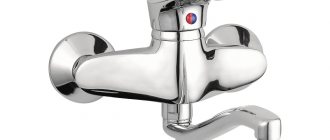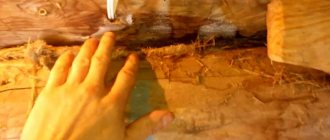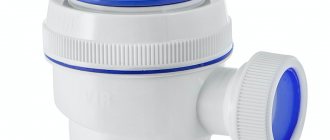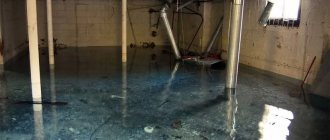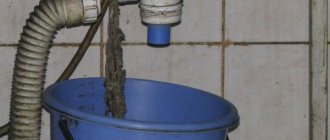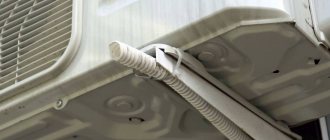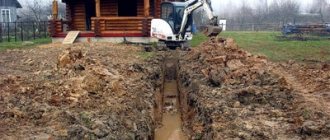A lot of concern for owners of apartments or private houses is caused by condensation on the sewer pipe in the toilet. Not everyone understands the physical essence of the process of moisture settling on cold surfaces. Some users mistake this effect for pipe leakage, since the amount of condensate can be quite large. At the same time, eliminating a leak is much easier than changing the operating conditions of the system or insulating the pipes. Often the source of the problem is on one floor, but the ceiling of the neighbors below gets wet. This is a serious issue and should be looked at more closely.
Why is it formed?
Condensation is expressed in the appearance of small drops of water or complete wetness of the surface of pipes with cold water.
There are only two main causes of condensation:
- an increase in air humidity caused by the appearance of a source of active evaporation of water;
- the appearance of colder surfaces, changing the temperature ratio and causing moisture to settle.
The conditions for the appearance of condensation are a combination of these factors, enhanced by a large difference in temperatures.
For example, if a constantly wet surface is heated, it will stop attracting water vapor.
Conversely, if it is cooled sharply, the appearance of condensation will become inevitable. This phenomenon in itself is not a sign of any dangerous or undesirable processes. Attention! Condensation is dangerous due to its consequences - moisture begins to be absorbed into the wall materials, dampness and mold appear, steel elements are destroyed (fasteners, plumbing parts, when penetrating deep into the concrete, the fittings begin to rust).
In the bathroom
The appearance of condensation in the bathroom can have various reasons:
- Immediately after taking water procedures (especially after a hot shower) is normal. If moisture covers all surfaces - tiles, mirrors and other cold surfaces, but quickly evaporates (in normal conditions this process takes only a few minutes), there is nothing to worry about. This indicates that the room has normal ventilation, which actively removes water vapor.
- Leaking hot water or hot water pipeline .
They are much more dangerous, as they pose a risk of flooding of the apartment, and not only your own. A particularly dangerous sign is a leak in a hot water pipe. This is evidenced by the constant appearance of steam in one area or another of the room. Hot water evaporates more actively and creates increased humidity in the air. Cold water pipes, on the contrary, attract condensation. If there is a leak (not necessarily in the pipeline itself, a possible cause could be a valve that is not closed tightly), the pipe is constantly wet.
In the toilet
In the toilet, condensation appears on the cold water pipes and on the flush tank (less often on the toilet itself).
The main reason is incorrectly configured tank mechanics , which creates a constant leak.
It is noticeable if you look closely at the upper area of the water outlet in the toilet bowl.
Reference! Most often, the problem can be resolved by adjusting the tank. As soon as the constant flow stops, moisture settling will noticeably decrease or stop altogether.
On the riser
Condensation on the riser indicates the appearance of a constant water leak either in your apartment or in the apartments of neighbors on the upper floors. The water does not stagnate and does not heat up, so the temperature of the riser is noticeably lower than that of surrounding objects.
If the water vapor content in the air is increased, the surface of the pipe will immediately become wet. If the reason lies in your apartment, eliminating it will not be much of a problem. It is worse if a constant leak occurs on the upper floors of neighbors, since it is sometimes extremely difficult to determine the source and somehow influence the residents.
Steam traps
Since the problem of water condensation is widespread, there are devices that capture water vapor and remove the resulting liquid. In particular, condensate drains are installed at the outlet of water heaters. Depending on the heat exchange scheme, thermodynamic, thermostatic and mechanical devices are used.
The most popular are condensate traps that operate on the float principle. They separate accumulated water from steam and remove it from the system, using the difference in density between water and steam.
Float devices have the following advantages:
- exceptional reliability;
- high performance;
- optimal energy saving in the system.
Does the material matter?
The material of the pipes has a significant influence on the occurrence of condensation.
The main indicator is thermal conductivity - the higher it is, the more moisture will settle on the surface.
pipes, both steel and brass, get wet the most
They quickly cool down when a cold stream passes and begin to attract water vapor from the air.
Plastic pipes are less susceptible to this phenomenon, since the thermal conductivity of polymers is much lower than that of metal.
On a note! The walls of plastic pipes have thermal insulation abilities that reduce the possibility of moisture settling. However, if the room is very hot and humid, the plastic surfaces will also become wet.
Methods for protecting metal pipelines
If condensation is not removed from metal cold water pipes, they will become corrosive over time. What can you do in this case:
- First, the surface of the pipes is cleaned of rust, then dried, covered with olive oil and oil paint.
- You can use carbonate paste in the form of a mass to seal cracks in the floor and walls. The composition is applied to the surface in a layer of 5 mm and allowed to harden for 24 hours. Then he grinds it. It is made with fine sandpaper and painted with oil paint.
- It is possible to use protective primers consisting of zinc dust diluted with olive oil and epoxy varnishes. The surface of the pipe is coated with these primers and then painted with paints and enamels.
- The toilet pipe can be coated with a varnish-based composition, sandpaper in a ratio of 20:80, or primer compositions such as GF-031, FL-03K, FL-053, GF-021.
If we are talking about a bathroom, then for painting hot pipes use oil-resistant enamels for painting towels, for cold weather - any enamels or paints.
In an apartment and in a private house - what is the difference?
Water supply systems for private and apartment buildings differ in size. The number of subscribers in the apartment building is very large, which creates conditions for constant cooling of the risers and cold water pipelines.
In a private house, the number of users is limited, so the water moves through the system less actively and has time to heat up a little. These few degrees are enough for the conditions for moisture deposition to change and the process to stop.
If a private house has an autonomous water supply system, then the water is not under strong pressure and flows into the premises more smoothly. Then evaporation appears only due to poor-quality ventilation, which does not have time to remove air supersaturated with moisture.
The roof is not insulated well enough
Quite often, the formation of condensation in the roof is associated with its poor insulation. Typically the problem is caused by the insulation material being too thin, allowing moisture to penetrate into the area of the slabs. However, the layer may have sufficient thickness, but its quality leaves much to be desired. In this case, at sub-zero temperatures outside, warm air will leave the room. Where warm and cold flows collide, droplets of water will settle, which will first fall into the attic, then can penetrate into the house, damaging the ceilings or walls.
To solve the problem, you need to understand how heat leaves the room. If the insulation layer is of high quality, but too thin, it needs to be strengthened. It is not necessary to re-insulate the entire structure; it is enough to wait until winter and observe at what points the material or metal base of the roof becomes wet.
If snow falls in your area, inspect it carefully. In the place where the heat leaves, it will be soft and begin to melt. A more complex way, which does not depend on the time of year, is to use a thermal imager. This is a special device that will help determine the exact location, but the services of a specialist or the purchase of the equipment itself are quite expensive.
How to determine the cause in each specific case?
First of all, you need to carefully inspect the room.
As a rule, it is the problem areas that get wet first - pipes, faience surfaces of plumbing fixtures and other low-temperature elements.
If all walls, mirrors and other surfaces sweat, it means that the source of moisture is the air itself.
It contains an excess amount of steam, which settles on any objects with a lower temperature.
If the cold water pipe gets wet, it means there is a leak through the faucet or household appliance (washing machine or dishwasher). Here you need to inspect the line and find the problematic faucet, the turned on water supply system or other devices.
If at a given moment in time a normal washing procedure, washing dishes or performing hygienic water procedures is being carried out, then everything is normal and the condensation will disappear when the work is completed.
Attention! If moisture is constantly present on the pipes, you need to find the leak and fix it.
Plumbers' tips for preventing leaks
All recommended methods offer optimal ways to solve the problem “Condensation on cold water pipes, what to do.” However, there are isolated cases when all protective measures have been taken, but moisture continues to accumulate on the “cold” pipeline.
You can use practical advice from professional plumbers on eliminating condensation:
- To rid the bathroom of high humidity, install a device called a “moisture absorber.” The device is a plastic box containing absorbent tablets. The absorbent will absorb excess moisture and dry condensation from the surface of the pipes.
- You can purchase a special product in specialized stores. After application to a water pipe, a durable film coating is formed on the surface, preventing the formation of condensation.
- An excellent solution to get rid of the appearance of unwanted moisture is guaranteed by installing a split system with an air dehumidification function, although this option is considered an expensive undertaking from a financial point of view.
Does it need to be cleaned?
The process of moisture deposition itself is not critical , but it is undesirable for walls and other objects surrounding pipes. Absorption of moisture contributes to the destruction of building materials, causing the appearance of fungus, mold, and insects.
If condensation occurs on polymer surfaces in well-ventilated areas, you may not be too afraid of this phenomenon.
It is enough to get rid of the causes of steam deposition, and no harmful consequences will arise.
It is more difficult when steel parts , structural elements of the house, and reinforcement of load-bearing walls get wet.
In these cases, the most effective measures must be taken immediately, including temporarily turning off the water and identifying the source of danger.
Danger of condensation
Installing a sealed double-glazed window not only provides comfort and warmth inside the room, but also prevents fresh air from entering the home. For this reason, the owner independently worsens the microclimate of the room.
Condensation on plastic windows is evidence of an unfavorable atmosphere in the apartment. High air humidity promotes the appearance of various types of bacteria, mold and fungal formations.
According to SNIP 2.04.05-91, in the living space the temperature should vary within 20-22 °C, and the moisture content should not exceed 30-45%. These conditions are optimal for a person’s comfortable stay in the room and there is no risk of windows fogging up. Therefore, condensation on the windows is the first sign of a violation of the microclimate of the room.
What to do if it appears?
The most effective ways to combat it would be to install a sealed shutoff on the pipes, or to stop the excessively active movement of water along the cold water lines. Let's consider the possible options.
On a metal pipeline
To eliminate condensation on metal pipes, various shutoff options are used. The task is to isolate the cold surface from the steam-saturated indoor air.
Different methods are used:
- The surface of the pipe is wrapped with synthetic fabric in several layers, between which a layer of epoxy putty is applied. The procedure is labor-intensive and time-consuming, but gives good results.
- Standard installation of a heat insulator (glass wool, slag wool, etc.) followed by installation of an impermeable protective sheet. This method is good for large pipelines installed in basements or utility rooms.
- Installation of foam or polyurethane foam shell. This is the simplest and most effective way to insulate metal pipes. The shell is a type of heat insulator in the form of a hose or two halves that are placed on the pipe and firmly fixed to it. It is necessary to completely eliminate cracks or gaps and ensure complete sealing of the surface.
On a plastic pipeline
Plastic pipes do not attract condensate too much, but the danger cannot be completely eliminated.
Therefore, to protect against moisture, you should use thermal insulation from ready-made profile elements (shells) or roll insulation.
The first option is more convenient, since wrapping insulation around a pipe located next to a wall and other communications is not easy.
Another way to protect plastic pipes is to install a protective box that completely cuts off contact between the pipe and moist air.
It is necessary to ensure tightness and absence of cracks or holes. Pipeline outlet areas are insulated using pieces of foam rubber , polyurethane foam or other soft and water-impermeable materials.
On the riser
Protection of the riser from condensation is carried out based on the material and location of the pipe. Usually several methods are used at once - cover the surface with a heat insulator and assemble a protective sealed box.
Reference! These measures give quite effective results. The main task is careful and thorough assembly of the insulation and the box, the complete absence of gaps or open areas.
How to get rid of condensation on pipes - basic methods of combating
The harmful effects of moisture on plumbing equipment and premises make us think about methods to combat the formation of condensation. Most of them are relatively simple and inexpensive.
Installing an exhaust fan in the bathroom
First of all, excess moisture is eliminated by an influx of fresh air. If there is no ventilation at all, it is advisable to organize it.
The operation of the existing system may be hampered by debris accumulated in the ventilation duct. You need to unscrew the grille and carefully clean out the dust and cobwebs from the hole.
You can verify the presence of traction by holding a lit match to the hole. If the draft is still insufficient, you need to buy and install a fan in the duct.
Installation of insulating tubes
High-quality insulation is one of the most effective ways.
Effective and inexpensive vapor-tight thermal insulation is made from polyethylene foam. This material is called energyflex and is sold in the form of finished tubes of various diameters or in rolls. Before use, the pipeline must be dried, then cut the elastic tunnel lengthwise and put it on the pipe. The joints are treated with polyurethane foam and secured with waterproof tape.
Applying epoxy putty
Homemade thermal insulation can be made from epoxy putty and old fabric scraps. The pipe is cleaned of traces of rust with sanding paper, wiped with acetone to remove grease and additionally with a special anti-rust agent.
Now a base layer of epoxy putty is applied to it and the still wet surface is quickly wrapped with strips of rags. Having wound two or three layers, the fabric is fixed with wire and a finishing layer of epoxy putty is applied on top of it. Now you need to wait until it dries and you can clean and paint the surface.
Temporary methods
If you do not have the necessary materials, or it is impossible to carry out the work at the moment, you can use simple methods. But you need to remember that they are not suitable for long-term use.
- Wrap a bandage around the wet pipe and place the tip in a container to collect water.
- Keep doors open at all times.
- Place moisture absorbers in the room, for example, silica gel balls in bags.
Preventing the problem from occurring
The most effective preventive measures can only be proactive actions:
- early installation of thermal insulation,
- box assembly,
- setting up equipment and cranes.
It is necessary to organize the water supply so that all cold surfaces are removed from contact with moist internal air.
Important! Preventative measures require effort and time, but they will avoid unpleasant consequences and protect the supporting and load-bearing structures of the house from destruction.
Thermal insulation of pipes
It is better to insulate all pipes in the house. For these purposes, specialized materials are purchased. But you can use the means at hand and rid your house of constantly wet pipes.
An ordinary plastic tube is cut lengthwise and placed on the problem area. The space between the pipes is filled with polyurethane foam.
A metal pipe can be easily secured with an old rag. To do this, we get rid of the rust, dry the pipe and wrap it with rags.
Sources:
- experttrub.ru
- pikucha.ru
- www.mitrey.ru
- fb.ru
There are no similar posts, but there are more interesting ones.
Use of special means
Many different materials are used as insulating material to protect pipes from condensation, depending on the specific situation.
The easiest way is to use pads made of foam material. They look like soft pipes with a longitudinal section
It is important to choose the correct size so that there is no space left between the material and the pipes
A very effective method, however also more expensive, is the use of heat-insulating paint. To properly insulate the pipes, it will need to be applied in about 5 layers, allowing each layer to dry.
In addition, plastic linings are also used for decoration. In this case, the space that forms inside these elements will need to be filled with ordinary polyurethane foam.
Please note: before starting insulation work, we must not forget about the need for pre-drying, because wet pipes cannot be insulated.
All of the listed methods for solving the problem of “sweating” are the most effective. However, if you do not have the necessary amount of money to purchase such expensive coatings, you can even make thermal insulation with your own hands. It is also possible to use Grafotherm chemicals, which will help eliminate fogging at any temperature.
How to cope with the consequences of temperature changes
To minimize the impact of temperature changes, it is necessary to insulate the cold water supply line. This can be done in several ways.
Materials for thermal insulation
The easiest way to use these types of insulating building materials is:
- Expanded polystyrene. It is considered a universal insulating building material for polymer water pipes. It is produced in the form of a shell, which consists of two halves. Installing a heat insulator is quite simple. The shell halves are wrapped around the pipe and secured with tape.
- Mineral wool for thermal insulation is sold in rolls. It is simply wrapped around the pipes, creating a protective casing.
- Polyurethane foam has increased insulating properties. It is applied to products during manufacturing in a layer up to 50 millimeters thick.
- Foamed polyethylene - Energoflex is produced in the form of cases that are easily put on pipe sections. Longitudinal seams are glued or fastened with clamps.
Another option for insulation is a plastic pipe with a large cross-section that fits over the main one. The resulting gap is filled with polyurethane foam. When performing any work on pipeline insulation, you will need to completely dry the surface from any condensation that has appeared in advance.
Insulating compounds
Isollat, a special paint for pipe insulation, allows you to avoid the appearance of condensation. This is a water emulsion that, after drying, turns into a polymer “case” with the effect of a thermos. The coating has excellent thermal insulation properties.
To get rid of moisture droplets, the surface of the pipeline is treated with chemical compounds: Stermizol, Corundum, Teplomet.
Correct application of insulating compounds:
- Clean the surface of the water pipe from dirt and rust.
- Apply a coat of primer to increase adhesion and leave to dry.
- Using a roller, brush or spray, cover the surface with the mixture, preferably in five layers. Each will take an hour to dry.
A special fixer, which at the same time imparts decorative appeal, allows you to increase the service life of a water pipe covered with a heat insulator.
Insulating the main line also helps if the pipework elements are located next to each other.
